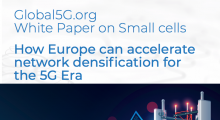Utilities: the role of 5G and technical viewpoints
The European Utilities Telecom Council (EUTC) represents the specific technical and regulatory interests of electric, gas and water utilities, all of which are considered critical infrastructures. Though part of the global Utilities Telecom Council (UTC), EUTC programmes are led by Europeans, designed by Europeans and have a unique European focus in the face of rapid technological change. Its members span major utility operators (large and small), e.g. in France, Germany, Holland, Ireland, Portugal, Spain and the UK. EUTC is part of a larger international group (UTC) covering the U.S., South America and Africa, dealing with mission-critical communication with global stakeholder engagement with the vendor and operator community for the alignment of new products, standards and spectrum allocation with the needs of the utility sector.
The Spectrum Working Group includes the development of technical reports and system reference documents with ETSI, liaison with 3GPP as appropriate, as well as The Critical Communications Association (TCCA). It is extending its work to ITU and its Study Groups to focus attention on utility operations for recognised spectrum access.
Viewpoints from Julian Stafford, Technical Director, EUTC (July 2019).
Utility specific telecommunications requirements
-
Very high availability (ranging from 99.9% to 99.9999% depending on the application).
-
Low latency, often <6ms round trip delay in safety-critical applications (tele-protection).
-
High degree of power autonomy required to enable gradual re-energizing of the electric grid in the event of a “black start” scenario, typically between 12 and 120 hours as dictated by the function of the edge device.
-
Cyber security: an increasing attack surface is created by the additional connectivity being introduced to utility networks. This increases exposure to unwanted attempts to disable critical infrastructure. Removal of the historic ‘air gap’ and ‘security by obscurity’ brings new challenges.
-
Ubiquitous coverage: a significant part of the utility infrastructure is located in rural areas with no connectivity. This is especially true of the increasing amount of small and medium scale solar and wind energy installation.
-
Throughput: generally low when compared with consumer based applications. However, additional functionality and encryption is increasing this by one or two orders of magnitude.
-
Longevity of solutions and support for legacy interfaces (25-30 year life spans are common).
-
Traffic prioritisation, especially for critical monitoring and control (SCADA).
Provision of services - current situation
A significant amount of self-provide, proprietary solutions, such as:
-
Narrowband UHF and VHF radio systems (12.5 kHz RF channels supporting 1,200 bits/second).
-
Self-provide fibre cables wrapped around overhead conductors.
-
Self-provide copper pairs installed adjacent to cables.
-
Millimetric microwave links (4-38 GHz).
-
Power line carrier systems in the LF & ELF range (approx. 10-50 kHz).
-
Some use of 3rd-party cellular (2G & 3G) - with mixed results.
-
Some use of satellite technology (VSAT & BGAN) - with mixed results.
Provision of services - future challenges and opportunities. An evolution in utility telecommunications is taking place right now, driven by global changes in energy production, storage and consumption. Distributed renewable energy generation and its place in reducing CO2 emissions.
-
Huge increase in electric vehicle adoption.
-
Peer to peer trading of electricity through smart phone applications.
-
The need for more efficiency coupled with control and visibility of devices at the edge of the network.
All of the above creates a huge increase in the number of connected devices on the grid and also the amount of data throughput required. Estimates indicate increases in both of these figures of between 10x and 100x.
This increase in demand represents one of the largest opportunities for 5G technology (as a mixture of both private and public network solutions) but only if the technology and networks are specified and deployed appropriately.
There are many parallels with other 5G use cases, including medicine, PPDR and autonomous vehicles.
Potential for symbiotic relationship
With the exception of densely packed urban areas, questions remain about the precise business model for mass 5G deployment, especially with regard to the very large increase in the number of cell sites at ever higher frequencies used in the RAN. There is much discussion around neutral host models, C-RAN etc. but it remains to be seen how successful these will be at scale and under different regulatory regimes.
Key uncertainties appear to be related to:
-
Access to cost-effective fibre backhaul.
-
Access to cost-effective, reliable power source.
-
Access to cost-effective support structures.
-
Willingness of consumers to pay significantly more for “all you can eat” data packages.
However, there is large potential for utilities and telecommunications to have a mutually beneficial relationship - with utilities requiring far more granular monitoring and control of their networks at the same time as having an abundance of the things that operators need for 5G deployment (power, backhaul, and vertical estate).
Further engagement between the utility sector and 5G expert groups could deliver very fruitful outcomes.
UTC White Papers and Articles for further reading
July 2019: The Smart Energy Blind Spot
March 2019: Cutting through the Hype: 5G and its Potential Impacts on Electric Utilities



